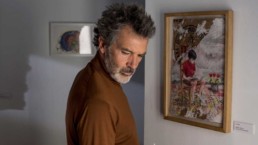In ‘Pain and Glory’, a Director Reflects on His Prolific Past
Only at the end is the line between reality and fantasy drawn, but by then you’ll have gone on such a fantastic ride it will hardly matter.
PAIN AND GLORY (2019)
Starring Antonio Banderas, Penelope Cruz, Asier Etxeandia
Directed by Pedro Almodóvar
Written by Pedro Almodóvar
Distributed by Sony Pictures Classics. 113 minutes. Opening 10/4 at The Landmark LA.
Pedro Almodóvar’s Pain and Glory is a lovely rumination on life, death, love, and, of course, pain and glory (although the latter hard-won and not cherished). It would be easy to consume this film as an autobiography.
This, after all, is a tale of a middle-aged film director experiencing a creative block brought on by both physical and seemingly spiritual pain after decades of prolific filmmaking. It’s made by the 70- year-old Almodóvar whose long and winding career has produced its share of masterpieces including Women on the Verge of a Nervous Breakdown and Oscar winners All About My Mother and Talk to Her, along with other films that never caught fire with the public.
While there’s plenty in Pain and Glory that’s self-referential (including the use of the director’s flat, wardrobe, and furniture) there’s also ample evidence that this is, as one character calls it, ‘autofiction’. Only at the end is the line between reality and fantasy drawn, but by then you’ll have gone on such a fantastic ride it will hardly matter.
Antonio Banderas, Almodóvar’s frequent alter ego, has never been better as Salvador Mallo, a director sidelined by crippling pain, which he is pacifying with a recently acquired heroin habit. Though not to worry—this tale isn’t told through a drug-infused haze, but rather with a crystal clear—and deeply colorful– lens.
Almodóvar is never afraid to examine his own foibles and frailties with a vision few of his filmmaking disciples can come close to.
The first third of the film’s action begins around Salvador’s decision on whether and with whom to attend a tribute screening of his classic 80s film, Sabor. But this is merely a device to set off a string of events that lead the director to look back when he can’t propel himself forward. “Without filmmaking my life is meaningless,” he says, yet it’s unclear what will motivate him to regain his creative footing.
The film skips through three periods of Salvador’s life: His childhood in the ’60s, when he and his impoverished parents lived in caves in Valencia, Spain and he fell for a neighborhood laborer; his adulthood in ’80s Madrid when his great, though tragic love affair occurred, and the present, where we see him become increasingly isolated and crippled psychologically as much as his body is physically impeded. Through these reflections, we learn about how his identity was formed, how he acquired his love for cinema, as well as his deep and stinging passions and losses.
The other guiding force of Pain and Glory, as is always the case with Almodóvar, is his palette of vibrant colors that bring magic to this film. The reds, greens, blues and bright patterns are alive in every scene, whether it be the operating room, an abandoned train station, the Valencia cave where the young Salvador and his family reside, or the dresses and scarves that his mother, played in her younger days by another Almodóvar regular Penelope Cruz, wears.
If Pain and Glory proves to be Almodóvar’s swan song, he’s going out in a blaze of glory. This is as profound, moving, and deeply engaging as a film you’re likely to see this year. It stands as another masterpiece from this Spanish auteur who is never afraid to examine his own foibles and frailties with a vision few of his filmmaking disciples can come close to.
Jane Greenstein
Jane Greenstein is a Los Angeles-based digital content strategist and freelance writer, covering arts and culture. Read more of her writing here: http://www.janegreenstein.com/blog/

